
On 6 March, Allied scouts confirmed that Santarem was empty and Wellington occupied the place the same day. Nearby bridges had been blown up, Junot’s and Reynier’s rearguard corps were already far away. Wellington sent the Light Division and Pack’s Brigade to follow them. He was still suspicious that Masséna might be trying to lure him into a trap but the following days and weeks confirmed that the French army was indeed retreating. The Anglo-Portuguese did not pursue the French closely, as Wellington wished only to follow the French and not to provoke a fight.
Another factor slowing the pursuit was the utterly ruinous state of the Portuguese towns and countryside that the Allied troops encountered. What little food and forage it might have contained had been plundered by the starved French for the last three months. All the rations and forage on which the Allied army depended had, therefore, to be transported from Lisbon. The desolation the British and Portuguese soldiers found in towns and hamlets recently vacated by the French was almost beyond belief. Santarem was a town of vandalised and half-destroyed houses. Filth and dead animals lay in the streets alongside the smashed remnants of fine furniture piled up as firewood. The villages lay in ruins, many buildings containing the remains of the unfortunate peasants who had stayed behind.16
As the French army marched north, Wellington instructed the commanders of the Portuguese militia corps, who would be faced with Masséna’s troops, to withdraw rather than fight. Not only would these irregulars be no match for the French veterans but both Wilson’s and Trant’s corps only amounted to about 6,000 troops.
As Wellington became convinced that Masséna was indeed leading his troops out of Portugal rather than staging some sort of feint, he pressed the pursuit more closely. Wellington had around 46,000 men, including 14,000 Portuguese to follow the French. The army consisted of the 1st, 3rd, 4th, 5th and 6th divisions, Pack’s and Ashworth’s Portuguese brigades with some cavalry and artillery. The new 7th Division, 5,100 strong, was being formed in Lisbon and not yet with Wellington’s Allied army. Wilson and Trant’s corps operating around Coimbra and in the country to the north amounted to only about 6,000 militiamen. They were not capable of facing the French army and were ordered to withdraw to Porto if the French marched on Coimbra.
Masséna’s army retreated in three columns under Reynier, Junot and Ney. In all, some 49,000 men marched north towards Coimbra. It was possible that Masséna would continue north and attempt to take Porto. Both Wellington and General Bacelar, the Portuguese commander in the area, knew the Portuguese could not resist such an assault. Wellington hoped that if they were closely pursued, the retreating French would be more inclined to head for the relative safety of the Almeida and Ciudad Rodrigo area in western Spain than to risk operations against Porto. Masséna faced the possibility of being caught between Wellington’s troops behind him and an untold number of Portuguese troops entrenched around Porto. However, if the pursuit relaxed Masséna may feel he had enough time to seize Porto. The 3,000 Allied cavalrymen, 500 of whom were Portuguese and the rest British or German, pursued the French relentlessly, closely followed by the Light Division.



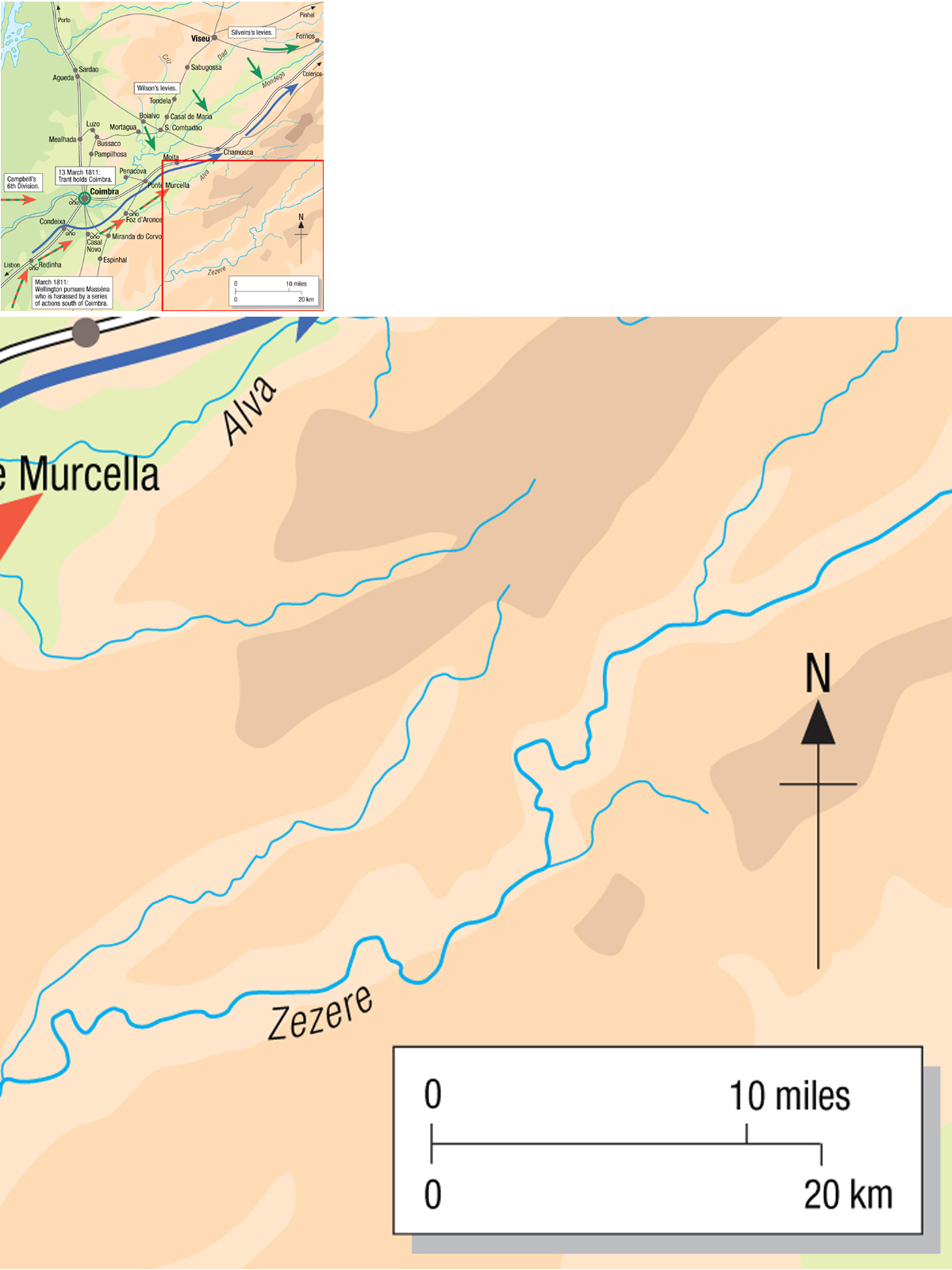
As the French neared Coimbra on 10 March, Masséna considered crossing the Mondego River to take it. He was hesitant, however, as intelligence had reached him that General Silveira’s troops had joined Trant’s in the city. The French believed that some 15,000 to 20,000 Portuguese troops were dug in defending the city. This was not the case at all. Although Trant and his Portuguese militia brigade remained in the city, they were, as per Wellington’s instructions, ready to retreat at the first sustained French attempt. There was no point in sacrificing Trant’s men. Heavy rains had caused the river to rise, making a crossing difficult while the British light troops to the south were catching up and skirmishing with the French rearguard. The next day a sharp skirmish occurred in Pombal in which the Allied Light Division and Picton’s 3rd Division clashed with Marshal Ney’s 6th Corps. British riflemen and Portuguese Cazadores pressed the French rearguard. Marshal Ney was, as always, at his best in combat, however, and quickly had a column drive the Allied vanguard back. The French rescued some troops stranded in Pombal’s old castle and fired part of the town. By this time the French were engaged with the 3rd, 4th and Light divisions and Ney withdrew his men. French losses at 63 were nevertheless nearly double those of the Allies at 37.
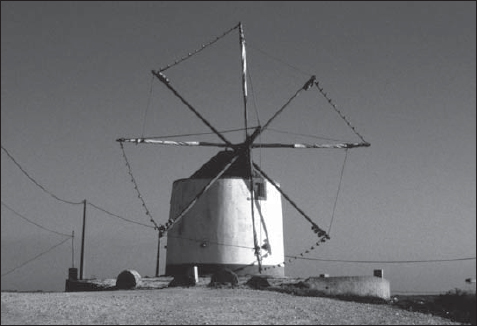
Windmill south of Sobral. This may have been the windmill from where Marshal Masséna surveyed the first line of Torres Vedras on 14 October 1810. (Photo: RC)
At Coimbra, Trant’s cannon were exchanging fire with French horse artillery across the river. The French generals were concerned that their army might be caught with its back to the Mondego River, trapped between the Portuguese in Coimbra and Wellington’s army. Part of Wellington’s army was, indeed, catching up with the French at Redinha, a town about 25 km south of Coimbra where a sizeable French rearguard was posted. It now seemed to Masséna that the wiser course was to forget about Coimbra and Porto and head east towards Spain. In a rather hasty move, Masséna sent Drouet with Conroux’s Division of the 9th Corps east towards Spain with instructions to contact Clarapède’s Division in the Colerico area. Masséna’s instinct to re-establish communications was sensible enough, but the effect was to weaken his army by some 5,000 men precisely when it was fighting off the pursuing Allied troops.
Wellington was indeed pursuing; on 12 March his Light, 3rd and 4th divisions and Pack’s Brigade reached Redinha close behind Julien Mermet’s rearguard division of Ney’s 6th Corps. Ney had also detached the 3rd Hussars, a few dragoon squadrons and eight guns. Wellington was cautious as his scouts had reported another French column about 8 km east, and that stragglers and invalids from Junot’s 8th Corps had been captured in the area. At about midday, the Light and 4th divisions, Pack’s Brigade and the 3rd Division were deployed from west to east in a line facing Mermet. With the Allied 1st and 6th divisions marching up the road from the south, Wellington’s force was much stronger than Ney’s, and at 2.00pm the British and Portuguese line advanced. Mermet’s flanks were turned by the Light Division to the west and Picton’s 3rd Division to the east. The fighting was intense but Ney knew that Mermet’s troops would have to withdraw or be overwhelmed. He had consequently instructed the colour party of each unit to fall back to positions 3 km north at the foot of a ridge where a new defence line would be formed. At Ney’s order, Mermet’s line withdrew in echelon to the new position. The French soldiers ran back in good order until they got to the narrow bridge over the Ancos River at the back of Redinha where something of a traffic jam occurred. Allied skirmishers had already reached the vicinity of the bridge and peppered the French who were crossing it. But other French troops were also crossing at pre-identified fords in the river. Picton tried to outflank Mermet to cut off his retreat but the move failed and the French deployed in their new position. It took some time for the Allied troops to cross and form a new line in front of the French. When, once again, Ney felt he was about to be overwhelmed, he gave the order to withdraw. It was now evening, and the British and Portuguese vanguard pursued the French some distance, but again Ney drew up two battalions in a double line on a ridge which poured a heavy fire on the Allied troops before retreating in good order. The French suffered 227 casualties and the Allies 205 but Ney had achieved his objectives; he had protected the rear of the army, his own corps rearguard had been safely withdrawn and Wellington had been delayed by a day.
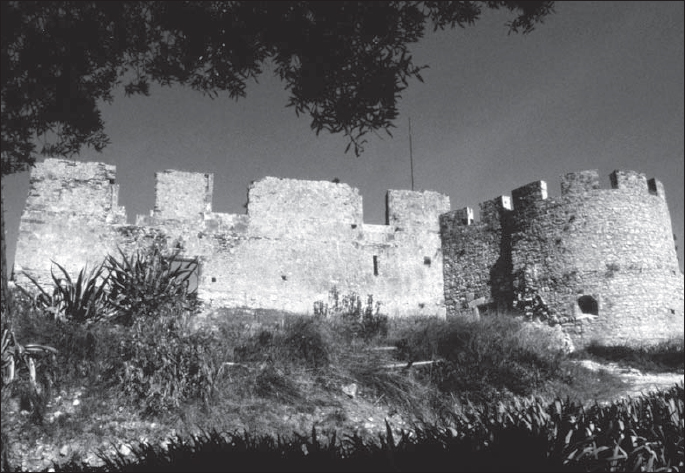
The medieval castle of Sao Vincente overlooking Torres Vedras. In 1810, it was one of the main redoubts of the lines. (Photo: RC)
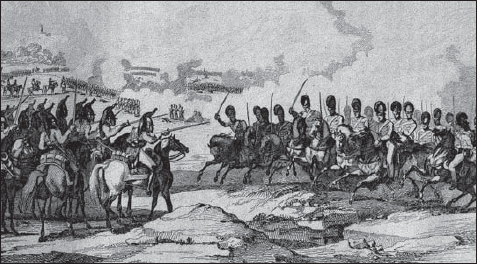
The battle of Redinha, 12 March 1811. This picture shows British light dragoons attacking French dragoons but the engagement was largely an infantry battle. (Print after Martinet)

The centre of the city of Torres Vedras. The castle of Sao Vincente is on top of the hill. (Photo: RC)
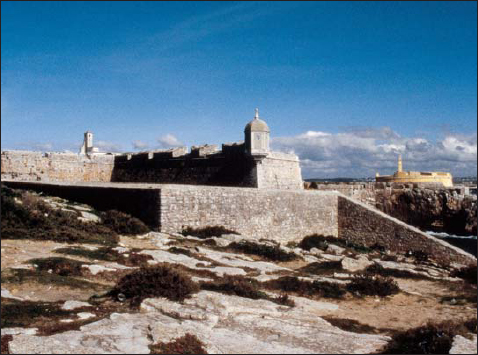
The fortress of Peniche on the seacoast north of the Lines of Torres Vedras remained in Anglo-Portuguese possession and posed a menace to Masséna’s northwestern flank. (Photo: RC)
On 13 March, Ney’s 6th Corps was deployed at Condeixa, about 12 km north, where the road was flanked by hills and afforded a good defensive position. The countryside was becoming increasingly mountainous as the armies moved north. Wellington used the same deployment as at Redinha, but this time the 3rd Division outflanked the French by making a detour through a mountain pass to the east, while the 6th Division did the same to the west. As a result, Ney became aware of a trickle of enemy troops appearing behind both flanks. There was no time to lose and he signalled a retreat lest his two divisions be caught, setting fire to Condeixa as he fell back hastily with Picton’s 3rd Division close behind. Only Ney’s speedy response allowed this narrow escape. The 6th Corps settled in at Casal Novo.
In the early evening, a curious incident occurred that was indicative of the closeness of the pursuit. A forward patrol of King’s German Legion hussars was already close to Fonte Cuberta, a village between Condeixa and Casal Novo, when it chanced upon a large party of French officers dining under the shade of a tree just outside the entrance to the village. Both sides were startled and the hussars hesitated, wondering what they had stumbled upon. At the same time some 50 French dragoons who were nearby ran to mount their horses. The Legion hussars had disturbed Marshal Masséna and his staff at dinner! A few grenadiers on guard formed up to protect Masséna, while the dragoons, who were Masséna’s escort, and some Aides de Camp prepared to charge the hussars. Meanwhile, Masséna and the other officers escaped in the opposite direction. Marbot, who was present, stated that if the ‘50 English hussars’ had charged immediately, they could have killed, wounded or captured Masséna.
In the event, Masséna reached Loison’s Division close by and blamed Ney for not covering the position with pickets. Ney had been dealing with Wellington’s intricate manoeuvres and had warned Masséna that he was withdrawing, however, the ADC with the message got lost and reached Masséna hours later. Some staff officers sympathetic to Masséna suspected Ney never actually sent a courier, which gives some indication of the extent to which relations had deteriorated between the two marshals.
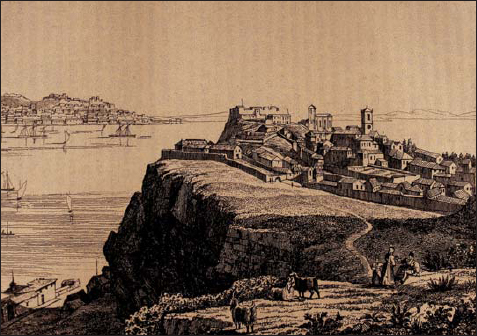
The fortress of Almada across the narrow entrance of the Tagus River guarded Lisbon’s southern flank. It was refurbished and garrisoned with Lisbon volunteers in 1810–11.
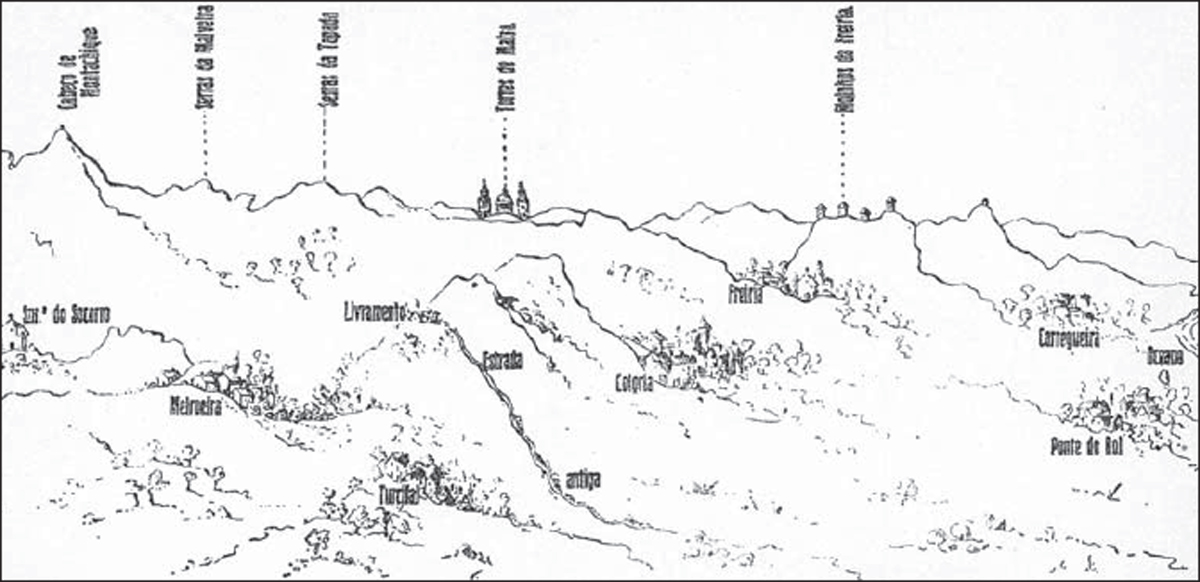
A view of the towns on the second line of Torres Vedras looking towards the southeast. The Atlantic Ocean is at right. The towers of the town of Mafra are at the centre in the distance. The topography as shown in this print is somewhat exaggerated.
The French continued to suffer from inadequate intelligence. Alexander Campbell’s 6th Division was operating separately from Wellington’s main force and was west of Coimbra by 13 March. The French scouts believed this was a new body of troops that had been landed by ship to join Wellington’s army. Coupled with the belief that there were substantial forces in Coimbra, this confirmed Masséna’s belief that retiring to Spain was the prudent option.
Early on 14 March, the British and Portuguese vanguard under Sir William Erskine ran into General Marchand’s French rearguard at Casal Novo. The fighting started in the early morning fog and the French held on until the fog lifted, by which time the five battalions of the Light Division were advancing, supported by the 3rd Division. Marchand withdrew to a second position further back which was eventually also vacated after some determined fighting. It was a fine rearguard action as Marchand’s men inflicted 155 casualties while losing a relatively modest 55 killed or wounded themselves.
The French army was heading northeast to take the main road leading to Colerico and, ultimately, the fortress of Almeida and Ciudad Rodrigo in Spain. Perhaps because of the incident with the German hussars, Masséna was keen to speed up the retreat. With their army approaching the mountains and the Anglo-Portuguese army closing on them from behind, the French urgently needed to lighten their load as much as possible. All wheeled transports including marshals’ carriages were destroyed, with the exception of some ammunition wagons. Many of the horses and donkeys were slaughtered although a number were still alive, wallowing in the mud when the British came up. It was a useless and barbaric act according to Grattan of the 52nd and Donaldson of the 94th, as the poor creatures were exhausted and of no use to the Allied army, which had sufficient numbers of good mules.
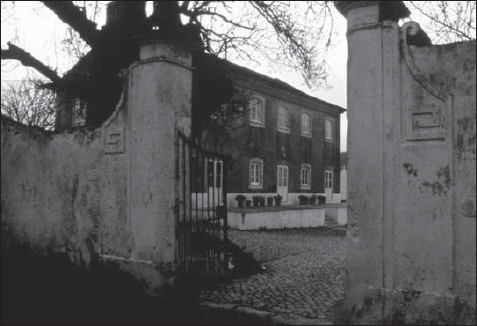
The mansion of the Baron of Manique where Wellington had his HQ at Pero Negro in the autumn of 1810. (Photo: RC)
Another worry during the retreat for Masséna was his mistress, Madame X. Now riding a horse, she fell several times as her mount stumbled over rocks in the darkness and she became so weak that she could no longer walk, having to be carried by a few sturdy grenadiers of Masséna’s escort. While asking his staff officers not to abandon her, he confided several times: ‘what an error I made in bringing a woman to war.’17
By 15 March, the French had reached Foz d’Aronce, indeed their 2nd Corps had passed it. Wellington was in close pursuit. Here another stand was made by the French, with Marchand’s and half of Mermet’s divisions of Ney’s 6th Corps once again deployed in front of the town, and Junot’s 8th Corps with the other half of Mermet’s Division on a ridge just beyond the Ceira River behind the town. There had been heavy fog earlier that day but by 4.00pm it had cleared, although Ney – who once again was in charge of the rearguard – did not expect an attack. Wellington on the contrary, saw this as an opportunity and pressed on. Picton’s 3rd Division and the Light Divisions were ordered to attack while Pack went west to outflank the French position. Once again, Mermet’s troops defended their ground with courage but lost heavily, finally blowing up the bridge over the Ceira in their retreat. French losses were heavy at about 250 while the Allied troops reported 71, a third of which were suffered by the 95th Rifles when a few companies of that unit broke through the French centre position. Wellington did not want to go any further; his men were exhausted and most of Masséna’s army could be seen on the hills beyond the Ceira River.
The next morning, 16 March, the hills were bare and the French army gone. Only a few small French detachments were visible. Curiously, Wellington seemed less anxious to pursue, which may have puzzled some of his officers as well as the enemy. Until this point Wellington could not be sure that Masséna, that ‘sly old fox’, would not try to storm Coimbra and march on Porto. Now, however, after this series of skirmishes, he had the satisfaction of knowing that Masséna was retreating towards the Spanish frontier. This must have given great joy to not only his British officers but also the Portuguese officers. A few days later, Wellington instructed that most of the militiamen and Ordenanza on duty at the Torres Vedras lines and other defences around Lisbon should be sent home. The crisis, which had begun with the invasion of Portugal in July 1810, was over.


The campaign, however, was far from over. Wellington’s army followed the French closely on their march towards Colerico along the main road south of the Mondego River. To discourage French raids and marauders, Trant’s and Wilson’s Portuguese militia brigades shadowed the French along the north bank of the Mondego. In the following days, hundreds of French deserters and stragglers were gathered by British and Portuguese troops as Masséna’s ragged army marched east. Some were also captured, notably General Loison’s ADC and his wife by a party of the 95th Rifles on 19 March.18 Finally, after many incidents, the French army reached the town of Colerico and united with Drouet’s 9th Corps. The worst may have seemed over to French soldiers, but further misfortune awaited.
On 22 March, Masséna issued orders that shocked the army to its core. Until then it had been understood the army would retreat into western Spain via Almeida. Now, with Almeida almost in sight, Masséna suddenly decided to march the army to Guarda instead, then south across the mountains into Spanish Estramadura. He then aimed to march back into Portugal again and occupy the upper Tagus River. Masséna’s wild scheme, plucked out of thin air, took no account of the state of the Army of Portugal – it was exhausted, lacking clothing, shoes and would soon lack food. It was also still being pursued by Wellington.
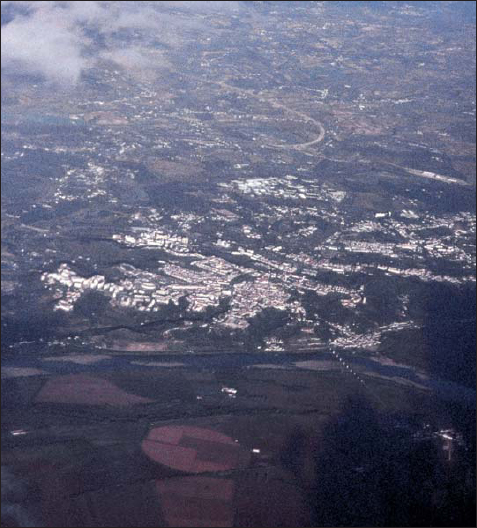
Aerial view of the Santarem area. (Photo: RC)
For Marshal Ney this was the last straw. In his opinion the army needed rest, clothing and food, which it could only get by marching to Almeida and into Spain. He could not bear to see his 6th Corps, which he had raised and served with since 1804, taken on such an adventure and announced that he was taking his corps to Almeida. His rage was incandescent and, on 22 March, he wrote three letters to Masséna within a few hours stating his position. This was gross insubordination and Masséna responded by relieving Ney from command. The army was shocked to see its favourite commander turned out by the unpopular Masséna. Had Ney refused to obey as some officers wished, the 6th Corps and perhaps the whole army might have taken his side. But he was not that kind of general. He obeyed Masséna and left for France. The command of the 6th Corps was given to General Loison.19
As events demonstrated, Masséna’s wild plan proved impossible to execute. By 27 March, both generals Reynier and Junot wrote to Masséna that their corps were close to starving, as there were no food or supplies to be had in the desolate and mountainous country further south. A day later, Masséna concluded that the only way out was to march east into Spain.

Napoleon’s interview with General Foy on 22 November 1810 regarding the French army’s campaign in Portugal.
With Wellington’s army not far behind, the French continued their retreat. They tarried a little in Guarda and by 29 March, two Allied cavalry brigades, the 3rd, 6th and Light divisions were in the town’s vicinity. They ran into Mermet’s, Marchand’s and Ferey’s divisions. Their commander, General Loison, was an able general, but he lacked the outstanding tactical ability of Marshal Ney, and he was taken by surprise as the Anglo-Portuguese troops arrived in Guarda, which his 6th Corps left in a hurry, trading shots with the Allied soldiers. On 31 March, the French crossed the Coa River. Masséna’s army had shrunk to less than 40,000 men during the retreat but now added the 4,500 men of Clarapède’s Division of 9th Corps posted around Almeida. He therefore decided to make a stand on the east side of the Coa in the area of Sabugal, about 30 km south of Almeida.
Even allowing for recently arrived reinforcements, with 38,000 men Wellington’s army was still smaller than Masséna’s, although this number did not include Pack’s Portuguese Brigade further west nor Trant’s and Wilson’s levies of irregulars who were on the north bank of the Mondego River. Wellington’s plan was to outflank Masséna from the south while Trant’s and Wilson’s Portuguese militias crossed the Coa River to threaten the French northern flank around Almeida. Drouet’s 9th Corps was thus preoccupied on that front, while the French 6th and 8th corps were strung out further south with the 2nd Corps somewhat isolated at Sabugal. Retaining the initiative, Wellington marched eastwards and, at the beginning of April, was in sight of Sabugal. The 6th Allied Division faced the French 6th Corps across the Coa River keeping Loison suitably worried while Wellington moved five divisions, some 30,000 men, to attack Sabugal and, he hoped, wipe out Reynier’s 2nd Corps. In the event Reynier was lucky, the Allies attacked on the morning of 3 April amidst a dense fog, which helped conceal their movements but proved very confusing. The 3rd and 5th Allied divisions decided not to advance blindly and asked Wellington for further orders. Not so General Esrkine, who commanded the Light Division. Without bothering to see the terrain himself, he sent an ADC to order the division and the cavalry to cross the river at previously identified fords. In the confusion the Light Division crossed at the wrong place, much closer to Sabugal than planned. The cavalry, taking its cue from the Light Division, was looking for a non-existent ford even further from its correct position, everyone was more or less lost in the fog. The French piquets of Reynier’s 2nd Corps on the east side of the river heard all this movement, and when they saw elements of Beckwith’s Brigade crossing the river, they opened a heavy fire. They were rapidly driven off by the men of the 43rd, 95th and the 3rd Cazadores, however, and the brigade formed up and marched on. Still in the fog, it ran into the 4th French Light Infantry Regiment as they were forming up, and they too were driven off. Additional troops from Pierre Merle’s Division were arriving, however, and soon, seven French battalions faced Beckwith’s Brigade. Rain now began to pour reducing the firepower of both sides. Beckwith, realising he was outnumbered and seeing no relief anywhere in the mist and rain, made for a nearby hill. Capturing a howitzer in the process, the 1,500 men of the brigade formed in a desperate stand on the slopes facing some 3,500 Frenchmen. Fortunately for Beckwith, the 2,000 men of the Light Division’s 2nd Brigade under Colonel Charles Drummond arrived on the scene, marching through the fog to the sound of the guns. The 52nd, 1st Cazadores and four companies of the 95th Rifles deployed and much confused fighting took place in the mist and rain. More French troops came up and at one point two French cavalry squadrons charged but, by chance, a squadron of the British 16th Light Dragoons arrived and helped drive them off. The British troopers had lost their way and headed for the gunfire. Erskine was by now totally confused and his orders ultimately prevented the rest of the cavalry from joining the battle.
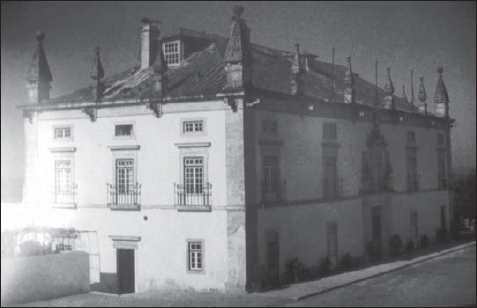
The town hall of Santarem in an old photograph. It was used by the French army in the fall and winter of 1810/11.

Map of the battle of Sabugal on 3 April 1811. One must bear in mind that this engagement was fought in a blinding fog with rain falling. The situation shown is during the latter part of the battle when the fog lifted. The British cavalry being somewhere south of the Coa River as a result of Erskine’s orders, the French slipped away to the west. The Anglo-Portuguese are shown in red, the French in green. (Luz Soriano, III)
Neither Wellington nor Reynier had any idea of what was going on, although the former guessed that little was going according to plan. The fog then lifted and he saw through the rain the bulk of the Light Division facing masses of French troops and their northern flank being turned by a French column. The spectacle was far from encouraging, but Reynier had little cause for joy as he could see the 3rd and 5th Allied divisions crossing the Coa River. Many thousands more Anglo-Portuguese troops would shortly join the fight. His corps would inevitably be crushed and Reynier immediately ordered a general retreat off to the east. Masséna’s line on the Coa River was pierced and in the afternoon the French army withdrew towards Spain.
The immensely destructive third invasion of Portugal, which had started in the summer of 1810, was over. But the threat of renewed invasion remained, and the French still held the strategic fortress of Almeida.
16 Sergeant Edward Costello of the 95th Rifles related a particularly grim incident when a Cazadore of the Light Division found the bayoneted and ‘mangled bodies’ of his parents, just murdered ‘their blood still warm’, and of his only sister ‘breathing her last, and exhibiting dreadful proofs of the brutality with which she had been violated.’ The cazadore, blinded with grief, saw French prisoners nearby and killed one and wounded another before being overcome by their guards and taken prisoner. He was later liberated when the circumstances became known to the commanding general. This sad incident nevertheless demonstrates that the Allied army took measures to protect French prisoners from wanton vengeance. The French treated the British prisoners with respect but not the Portuguese and Spanish.
17 Marbot, Vol. II, p.435. Marbot also mentioned that Marshal Ney could not stand Madame X and would not dine with Masséna if she was present.
18 John Kinkaid, Adventures in the Rifle Brigade (London, 1830), p. 62. The ADC was described as ‘a Portuguese, and a traitor, and looked very like a man who would be hanged’ while his wife ‘who was dressed in a splendid hussar uniform … was a Spaniard, and very handsome, and looked like a woman who would get married again.’
19 Masséna immediately sent Colonel Jean-Jacques Pelet, his ADC, to Paris so his version would be heard first by the emperor. When Ney got to Paris, he was gently admonished by Napoleon and then given further important commands. On Loison, see Campaign 90 Vimeiro 1808.